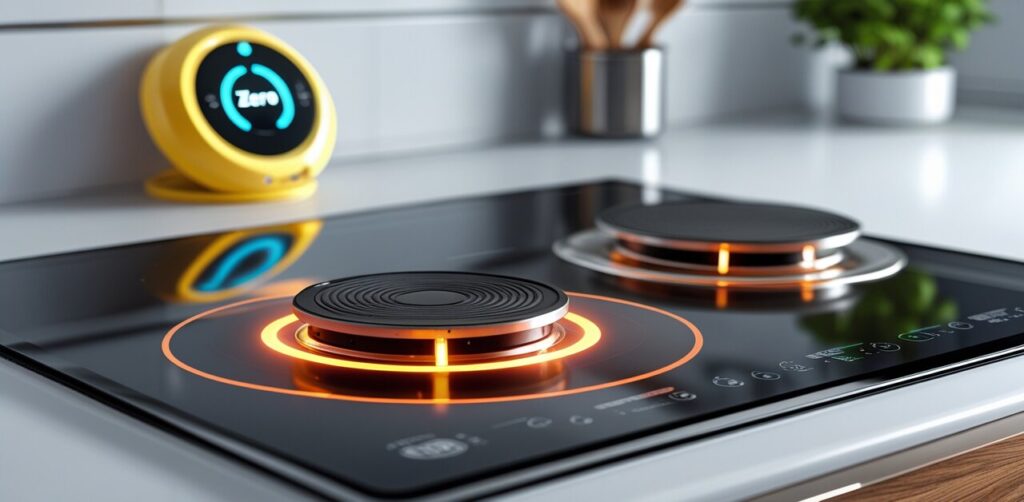Kitchen safety is a top priority for homeowners, chefs, and culinary enthusiasts alike. With cooking being an essential part of our daily routines, it’s vital to ensure that the tools we use are safe and reliable. Over the years, electric stoves have gained popularity for their ease of use, energy efficiency, and sleek designs. However, one common question arises among users and renovators—can electric stoves cause carbon monoxide?
This blog post clears any misconceptions, while offering practical tips and insights into the safety, efficiency, and environmental benefits of using electric stoves.
Understanding the Difference Between Gas and Electric Stoves
Before we address carbon monoxide, it’s essential to understand how gas and electric stoves operate.
Gas Stoves
Gas stoves use natural gas or propane as fuel, which burns to generate heat for cooking. While they provide precise flame control and quick heating, they come with some risks, such as carbon monoxide leaks, gas leaks, and explosions if improperly used or maintained.
Key Features:
- Uses open flames
- Requires a gas line connection
- Produces carbon dioxide and carbon monoxide as part of combustion
Electric Stoves
Electric stoves, on the other hand, use electricity to heat up metal coils or ceramic glass surfaces, providing evenly distributed heat. They don’t rely on fuel combustion, making them inherently safer in several respects.
Key Features:
- No open flames
- Runs solely on electricity
- No gas emissions during operation
Safety Insight: The lack of combustion in electric stoves eliminates the risk of carbon monoxide, which sets them apart from gas stoves in terms of safety.
Can Electric Stoves Cause Carbon Monoxide?
The short answer is no—electric stoves cannot produce carbon monoxide during normal operation. Carbon monoxide (CO) is an odorless and colorless gas typically generated when carbon-based fuels, such as propane, natural gas, or wood, are burned incompletely. Since electric stoves don’t burn any fuel, there’s no possibility of CO creation.
Despite this, homeowners should remain cautious when using any kitchen appliance. Improper cleaning, damaged wiring, or faulty components in an electric stove can still lead to other hazards.
Busting the Myth
The misconception that electric stoves might emit CO likely stems from their gas-powered counterparts. This confusion highlights the importance of knowing how different appliances function to use them safely.
When to Worry
While electric stoves are free from CO risks, households that use gas ovens, indoor charcoal grilling, or malfunctioning HVAC systems should maintain CO detectors to avoid exposure.
Tip: Check your home’s CO detector at least twice a year for battery life and functionality, even if you use an electric stove.
Safety Features of Electric Stoves
Modern electric stoves are equipped with advanced safety features that improve both performance and peace of mind.
Built-In Safety Features
- Automatic Shut-Off
Many electric stoves automatically turn off after a period of inactivity, reducing the risk of leaving the appliance unintentionally.
- Cool-Touch Surfaces
Smooth-top electric stoves typically remain cooler to the touch compared to open flames, reducing burn risks.
- Child Lock Settings
Designed to keep curious little ones out of trouble, child lock features can disable controls while not in use.
- Temperature Control
Precise temperature settings prevent overheating and ensure consistent cooking results.
- Residual Heat Indicators
A helpful indicator light remains on as long as the stove surface is still warm, ensuring safe handling.
These features make electric stoves a popular choice for families, culinary enthusiasts, and anyone looking for a safer alternative to gas stoves.
Tips for Safe Electric Stove Use
While electric stoves are generally low-risk, safety habits are still essential for proper use. Here are some best practices to follow:
- Inspect Wiring
Regularly check the stove’s power cord and outlet for any signs of fraying or damage.
- Clean Regularly
Keep the surface and burners clean to avoid grease buildup, which can cause smoke or even small fires.
- Avoid Overloading Circuits
Don’t plug your electric stove into outlets shared with high-power appliances, as this can lead to electrical malfunctions.
- Unplug When Not in Use
For extended vacations or downtime, unplug the stove entirely to save energy and eliminate potential risks.
- Follow Manufacturer’s Guidelines
Always read the manual and follow manufacturer-recommended cleaning and maintenance routines.
By following these tips, you can enhance both the safety and efficiency of your electric stove.
The Environmental and Economic Benefits of Electric Stoves
Aside from safety, electric stoves are gaining attention for their eco-friendly and cost-saving benefits.
Environmentally Friendly
Electric stoves reduce greenhouse gas emissions compared to gas stoves. When paired with renewable energy sources, they become even more sustainable, making them a smart choice for energy-efficient living.
Economic Advantages
- Lower Initial Cost
Generally, electric stoves are more affordable to install than gas stoves, which require additional gas line hookups.
- Energy Efficiency
Electric stoves provide consistent and precise heating, which reduces energy waste. Induction models, in particular, are known for their high efficiency.
- Durability
Electric stoves often have fewer moving parts, reducing the need for frequent maintenance and repairs.
Choosing an electric stove is not only an investment in your kitchen’s safety, but also a step toward long-term cost savings and environmental responsibility.
FAQs About Electric Stoves
1. Do I Need a CO Detector if I Use an Electric Stove?
While electric stoves don’t produce carbon monoxide, every household should have a working CO detector to guard against risks from other appliances or HVAC systems.
2. Are Electric Stoves More Expensive to Run Than Gas Stoves?
Electric stoves can be slightly more expensive in areas with high electricity rates, but their energy efficiency often offsets this cost over time.
3. Can Electric Stoves Cause Fires?
Improper use, such as leaving a cloth or flammable item on the stovetop, can lead to fires. However, built-in safety features significantly reduce this risk.
4. Can Electric Stoves Replace Gas Stoves for Professional Cooking?
Yes! Many professional chefs are transitioning to electric induction stoves for their precision, efficiency, and safety.
5. What’s the Best Way to Clean My Electric Stove?
For smooth tops, use a non-abrasive cleaner specifically designed for glass or ceramic surfaces. For coil models, remove the burner and drip pans for cleaning.
Prioritize Safety and Efficiency with Electric Stoves
Electric stoves offer a safer, cleaner, and more environmentally friendly way to cook. By eliminating the risk of carbon monoxide and incorporating advanced safety features, they provide peace of mind without compromising performance. Whether you’re a culinary enthusiast or a busy parent, electric stoves are an excellent choice for your kitchen.
Looking to upgrade or switch to an electric stove? Keep safety and energy efficiency top of mind. After all, the best kitchens are a blend of functionality, style, and peace of mind.



